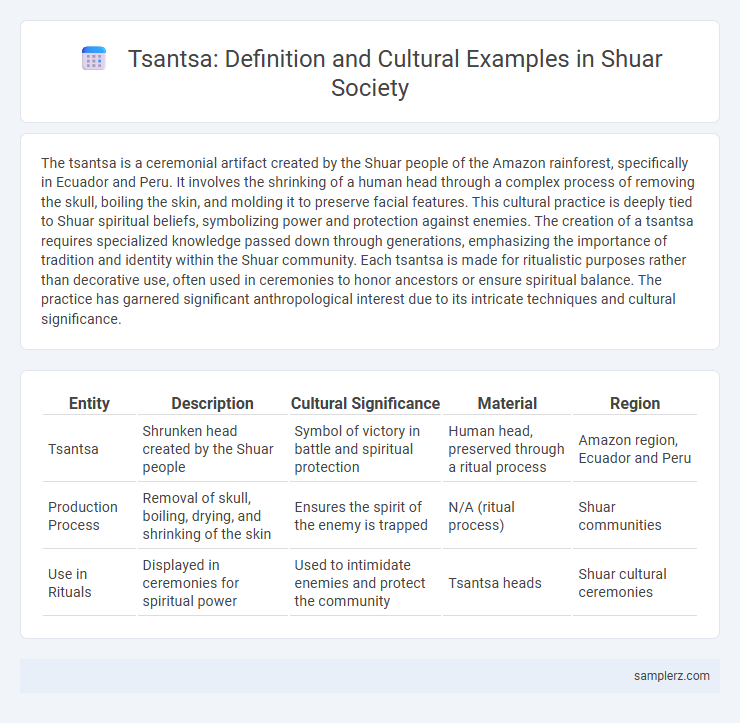The tsantsa is a ceremonial artifact created by the Shuar people of the Amazon rainforest, specifically in Ecuador and Peru. It involves the shrinking of a human head through a complex process of removing the skull, boiling the skin, and molding it to preserve facial features. This cultural practice is deeply tied to Shuar spiritual beliefs, symbolizing power and protection against enemies. The creation of a tsantsa requires specialized knowledge passed down through generations, emphasizing the importance of tradition and identity within the Shuar community. Each tsantsa is made for ritualistic purposes rather than decorative use, often used in ceremonies to honor ancestors or ensure spiritual balance. The practice has garnered significant anthropological interest due to its intricate techniques and cultural significance.
Table of Comparison
| Entity | Description | Cultural Significance | Material | Region |
|---|---|---|---|---|
| Tsantsa | Shrunken head created by the Shuar people | Symbol of victory in battle and spiritual protection | Human head, preserved through a ritual process | Amazon region, Ecuador and Peru |
| Production Process | Removal of skull, boiling, drying, and shrinking of the skin | Ensures the spirit of the enemy is trapped | N/A (ritual process) | Shuar communities |
| Use in Rituals | Displayed in ceremonies for spiritual power | Used to intimidate enemies and protect the community | Tsantsa heads | Shuar cultural ceremonies |
Origins of Tsantsa in Shuar Culture
The origins of tsantsa in Shuar culture trace back to their spiritual beliefs and warrior traditions, where shrinking heads of enemies symbolized power and protection. This practice served both as a trophy of triumph in battle and a means to harness the captured spirit, preventing it from avenging the death of its owner. Tsantsa represented a complex fusion of Shuar cosmology, social status, and ancestral veneration, deeply embedded in their indigenous rituals and identity.
Traditional Methods: How Tsantsa Are Made
Tsantsa, or shrunken heads, are made by the Shuar through a meticulous traditional process involving careful removal of the skull, boiling of the skin, and repeated molding to preserve facial features. Salt and hot stones are used to shrink and cure the skin, preventing decay while maintaining the head's facial structure and expression. The process is deeply rooted in Shuar spiritual beliefs, intended to harness the power of the enemy's spirit and provide protection.
Symbolic Meaning of Tsantsa Among the Shuar
Tsantsa, or shrunken heads, hold profound symbolic meaning among the Shuar people, representing both spiritual power and social status. These artifacts are believed to capture the soul of an enemy, preventing their spirit from seeking vengeance and transferring strength to the warrior. The ritual process of creating a tsantsa reflects complex beliefs about life, death, and protection within Shuar culture.
Ceremonial Uses of Tsantsa in Community Rituals
Tsantsa, also known as shrunken heads, play a significant role in Shuar community rituals as ceremonial objects symbolizing power and protection. These preserved heads are used in spiritual ceremonies to honor ancestral spirits and to assert dominance over enemies, reinforcing social cohesion and cultural identity. The process of creating tsantsa involves intricate rituals that imbue the artifacts with sacred meaning, shaping their importance within Shuar cultural traditions.
Historical Accounts of Shuar Tsantsa Practices
Shuar tsantsa, traditionally crafted by the indigenous Shuar people of the Amazon rainforest, involved the shrinking of enemy heads as a ritualistic practice symbolizing spiritual and physical dominance. Historical accounts from early explorers and anthropologists document the meticulous process of skinning, boiling, and shrinking the heads, intended to harness the captured spirit's power and prevent its revenge. The practice, steeped in complex cultural and religious beliefs, offers critical insights into Shuar identity, warfare, and cosmology during the pre-contact and colonial periods.
Tsantsa as Social Status and Power Symbols
Tsantsa, the shrunken heads crafted by the Shuar people, functioned as potent symbols of social status and power within their communities. Possession of tsantsa signified a warrior's prowess in battle and his ability to protect and lead, elevating his rank and influence. These artifacts were integral to rituals and social hierarchy, reinforcing authority and spiritual strength among the Shuar.
Impact of Western Interest on Tsantsa Traditions
Western interest in tsantsa, or shrunken heads, significantly altered Shuar cultural practices, leading to the commodification of these sacred objects for collectors and tourists. Increased demand encouraged the production of counterfeit tsantsa, undermining traditional spiritual and ceremonial values. This external influence disrupted the Shuar's cultural continuity and prompted legal restrictions aimed at curbing the exploitation of tsantsa artifacts.
Current Perspectives on Tsantsa in Shuar Society
Tsantsa, or shrunken heads, once served as powerful spiritual and social symbols within Shuar culture, embodying warrior prowess and ancestral reverence. Contemporary Shuar perspectives have shifted toward cultural preservation and education, emphasizing the practice's symbolic significance while condemning historical violence associated with tsantsa production. Efforts to protect Shuar cultural heritage involve promoting awareness through museums and legal frameworks that prohibit the commercial trade of authentic tsantsas.
Ethical Issues Surrounding Tsantsa Collection and Display
The practice of collecting and displaying Shuar tsantsas (shrunken heads) raises significant ethical concerns tied to cultural appropriation, consent, and the commodification of indigenous heritage. Museums and private collectors often face criticism for acquiring tsantsas without the Shuar community's permission, leading to debates about rightful ownership and the respect for ancestral spiritual beliefs. Efforts to repatriate tsantsas highlight the importance of honoring Shuar cultural integrity and addressing historical injustices linked to colonial exploitation.
Preserving Shuar Heritage: The Future of Tsantsa Practices
Tsantsa, the traditional shrunken heads crafted by the Shuar people of the Amazon, symbolize a profound cultural heritage intertwined with spiritual beliefs and ancestral identity. Efforts to preserve Shuar heritage emphasize respectful education and controlled cultural tourism, ensuring authentic practices and stories are maintained. Future initiatives focus on community-led preservation projects, combining modern technology with indigenous knowledge to protect tsantsa traditions and foster greater global awareness.

example of tsantsa in Shuar Infographic
 samplerz.com
samplerz.com